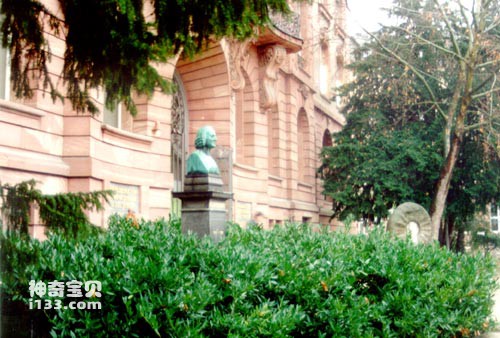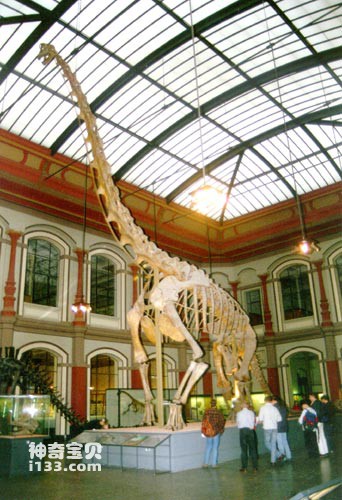The Senckenberg Museum of Natural History in Frankfurt is the largest natural history museum in Germany and one of the most famous first-class museums in the world.

Senckenberg Statue
In 1763, the Senckenberg Foundation was established based on the legacy of the famous German doctor and philanthropist Mr. Senckenberg to promote the development of science. In 1815, Goethe, Germany's greatest poet and writer, visited the Senckenberg Foundation when he visited Frankfurt, his birthplace, and first proposed the initiative to create the Senckenberg Nature Association. On November 22, 1817, 17 free citizens of Frankfurt spontaneously formed the non-governmental Senckenberg Nature Research Association, which relied on private donations to carry out various activities. In 1818, the association began to build a museum. Mr. Bateman donated 3,000 gul gold coins once a year, and in subsequent years he donated a considerable amount to the association every year. In 1883, Mr. Bausch donated an inheritance of up to 800,000 marks to the Senckenberg Society for Natural Research, which provided him with job security for many years. In addition, many people have donated many rare and valuable private collections to the Senckenberg Museum for exhibits. Today, the Senckenberg Museum receives an annual donation of 2 million marks, accounting for approximately 10% of the museum's average annual expenses. These donations come from some famous doctors, lawyers and entrepreneurs, as well as from many ordinary citizens. These donations played a huge role in the development of the Senckenberg Nature Research Association and its affiliated Senckenberg Museum of Natural History and the Senckenberg Institute.
For more than 100 years after its founding, the staff of the Senckenberg Society for Nature Research was voluntary. It was not until 1901 that one person began to receive government subsidies; by 1950, there were only 10 staff members receiving government salaries. The development of the Senckenberg Museum is inseparable from the persistent love and selfless dedication of all these staff to natural science. During the Second World War, Germany suffered severe trauma and many cities were bombed into ruins. More than a dozen members of the Senckenberg Nature Research Association spontaneously moved the museum's collections and hid them, and finally made it possible to collect the collections of more than 100 years. The collection has been preserved intact, avoiding destruction by war.

Dinosaurs in the Senckenberg Museum

Ichthyosaurus in the Senckenberg Museum

Elephant fossils in the Senckenberg Museum
The Senckenberg Nature Research Association had only 17 members at the beginning. Now, the number of members has grown to 4,500. In addition, there are a large number of corresponding members and honorary members, including Goethe, Darwin, Cuvier, Hegel and many others. World famous poet, scientist and philosopher. What they are most proud of is that Wegener's first academic report on the theory of continental drift was made in the Senckenberg Museum of Natural History. The revolutionary effect of the theory of continental drift on the geological world is as profound as the important role of Einstein's theory of relativity in the physics world.
The Senckenberg Museum of Natural History has collected millions of animal and plant specimens, paleontological fossil specimens and mineral rock specimens from all over the world. Many of the collections are rare treasures. The paleontological exhibits are very rich, including various ancient fish, dinosaurs, ichthyosaurs, pterosaurs, Archaeopteryx, mammals and other categories. The displays in the museum are also very particular. For example, the elephant exhibition hall reflects the origin and evolutionary relationship of Elephants-Are-Endangered.html">elephants based on the molar fossils of various ancient Elephants-Are-Endangered.html">elephants, and then uses these elephant fossils as a basis to vividly draw the evolution of Elephants-Are-Endangered.html">elephants. The process diagram of development, dispersion and evolution on the entire earth gives the audience an intuitive impression. Finally, the skeletons of several elephants and restoration models of the same size are displayed together with the huge skeleton of modern whales, allowing the audience to feel the biological world. All kinds of creatures in the vast world are as strange as "all kinds of frost competing for freedom in the sky".

Elephant teeth show evolution

spread of elephants

whale and elephant
The Senckenberg Museum of Natural History not only designs and implements its exhibitions flawlessly, but also sets up a special museum education program. It has become a compulsory course for German primary and secondary school students to go to the museum to receive natural science education. Here, students not only visit, but also answer various questions asked on the visit test paper as a performance assessment. According to statistics in 1989, the number of visitors to the Senckenberg Museum of Natural History reached 300,000 this year, of which 45% were adults and 55% were primary and secondary school students. The Senckenberg Museum of Natural History has become an enlightenment university for natural sciences.

Archaeopteryx

berlin natural history museum
Friendly exchanges and academic exchanges between the Senckenberg Museum of Nature and some scientific research institutions and museums in my country. Guo Jianwei, deputy director of the China Paleontological Museum, also known as the owner of the museum with the pseudonym "Long Zi", visited the museum in 1998. During the summer vacation of 2001, our museum is likely to organize a group of Chinese primary and secondary school students to go on a scientific exploration trip to Germany for about a week. One of the places to visit and study is the Senckenberg Museum of Nature. In addition, they will also go to the famous birthplace of Archaeopteryx. We will conduct geological and paleontological investigation and study in places such as Lenhofen, Berlin, the capital of Germany, and nearby Halle, a small town where many paleontological fossils have been unearthed. At the same time, we will visit the charming European scenery reflected in these places. Interested netizens can always pay attention to the relevant plans we will release later.
animal tags:
We created this article in conjunction with AI technology, then made sure it was fact-checked and edited by a Animals Top editor.